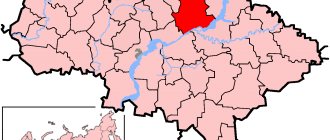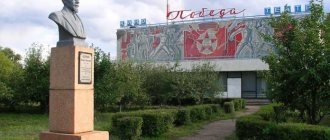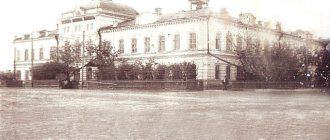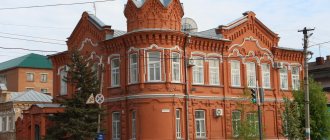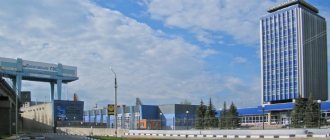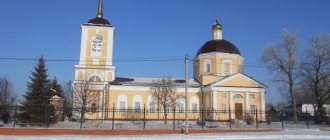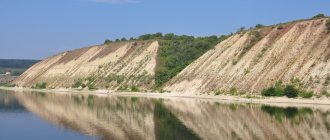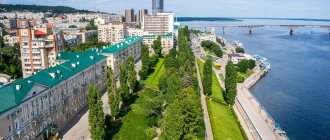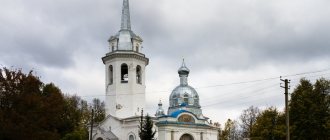This term has other meanings, see Volsk (meanings).
Coat of arms
| City | |
| Volsk | |
- 148 km²
Moscow
Saratov
Volsk
Media files on Wikimedia CommonsVolsk
- a city (since 1780) in Russia, the administrative center of the Volsky district of the Saratov region.
Located on the right bank of the Volga, 147 km northeast of Saratov. Pre-dead end railway station of the Volga Railway on a branch from Volsk 2 station[3].
Population - 61,943[2] people. (2020). Since 2015, Volsk has been awarded the title of City of Labor Glory of the Saratov Region[4][5].
central square
The main city square has a regular rectangular shape.
Along the perimeter of the square there are several beautiful buildings - former mansions, one of which is now a bank, and the other an art gallery. After the actual reconstruction, the city administration building located here has somewhat changed its original appearance. But the historical building of Gostiny Dvor is still well preserved.
Holy Trinity Cathedral
Built in 1809, the cathedral has a long and tragic fate, but a happy ending. After the revolution, fighting against religious prejudices, active Bolsheviks demolished the cathedral building and in its place erected a monument to their revolutionary leader, Lenin.
But at the beginning of this century, justice still triumphed and the temple was restored within three years and now again serves and adorns the city.
Built by love
Soon after the devastating fire of 1792, a regular building plan was developed for the city, which included the creation of a rectangular grid of streets.
The rapid growth of young Volsk is inextricably linked with the name of its second head, Vasily Alekseevich Zlobin, who was not yet 25 years old when he took office in 1784. Born into a more than modest family of a volost clerk, courteous and gentle in his dealings with everyone, Vasily Zlobin rose to the level of one of the richest merchants of his time thanks to chance: with his disposition and helpfulness he was able to make the most positive impression on the prosecutor general who was passing through Malykovka, a favorite Catherine of Prince Vyazemsky. Having first assisted him in choosing lands, he soon began to manage his estates, after which he finally moved to St. Petersburg, taking up trade and farming. Under the wing of an influential patron, Vasily Alekseevich, who had recently been a poor shepherd, quickly became a millionaire, and through his good nature, generosity, simplicity and intelligence, acquired the most useful acquaintances in the capital. He owned wine farms, took contracts for the supply of food to the army, Moscow and St. Petersburg, maintained fisheries in Astrakhan, Saratov and Volsk, supplied salt to twenty provinces of Russia...
Living in St. Petersburg, Zlobin never forgot his small homeland - he constantly took care of the beautification of the city, the construction of new beautiful buildings, bringing the charm of the capital's exquisite architecture to the banks of the Volga. He truly loved Volsk; suffice it to say that of all the many awards and thanks he received, he most valued the title of “eminent citizen”, awarded by grateful Volsk residents for impeccable service by the head of the city.
Having a unique talent for trade speculation, having mortgaged a large number of unfinished buildings in his native Volsk at a deliberately inflated price, Zlobin at the same time was extremely generous and sacrificial when it came to public benefit or serving the state treasury. He not only gave out alms in an unusually abundant manner, forgave considerable sums to debtors, showed unprecedented hospitality, and made outright losses for the benefit of the treasury, but also happily donated to public needs. With his care, new lighting appeared in the capital, hospitals, gardens, greenhouses appeared in Volsk and other cities. Zlobin initiated the installation of a monument to Minin and Pozharsky in Nizhny Novgorod, donating a considerable amount for this. Now this monument adorns the main square of the country, being one of the most recognizable symbols of Moscow. Thanks to the generous hand of Vasily Alekseevich, who turned a blind eye to the often not entirely honest attitude towards himself, many of his partners, contractors and managers were able to break out into the public. Zlobin’s impeccable aesthetic taste, taken as a model by his followers, determined the architectural appearance of Volsk, the absolute dominant feature of which was churches. Vasily Alekseevich himself, donating for the construction and decoration of churches, did not distinguish between the dominant Orthodox Church and the schismatic Old Believers, understanding the unnaturalness of the division.
Through Zlobin’s diligence, by 1809, a cathedral in honor of the Life-Giving Trinity was built on the site of the dismantled dilapidated Kazan Church. In the same year, the construction of a new cathedral in honor of the Beheading of John the Baptist began on the city's Trade Square, more consistent with the new status of a prosperous merchant city. By that time, the construction of the architecturally unique two-story Gostiny Row, the front colonnade of which stretched for an entire block, had already been completed on the square. Not a single county town in the Volga region had a commercial building with a gallery on the second floor.
The Patriotic War of 1812 made its own adjustments to the peace plans of wealthy Volchan residents. Vasily Zlobin's affairs were seriously shaken: a restriction was introduced on the sale of wine, taxes and fees on merchants were increased, and part of the proceeds was hidden by his partners. In addition, an old acquaintance of Vasily Alekseevich, Count Guryev, with whom he had long had strained relations, became the new Minister of Finance.
But the main misfortune befell Vasily Alekseevich the following year: his son Konstantin died suddenly. Zlobin fell into depression, ceased to be interested in business, and died the following year, 1814. It turned out that his debts to the treasury were covered by less than half. The bankrupt Volsky merchants, whose capital was at Zlobin’s disposal, were prohibited from conducting trade operations; many prominent merchants joined the city’s petty-bourgeois class. For many years, the city with its large, abandoned stone long-term construction projects looked empty and unattractive.
Gostiny Dvor building
A large, bright building, decorated on all sides with high columns, like many other city buildings, was built according to the design of the architect Zlobin. According to the plan, shopping arcades were supposed to be located here, but the war with Napoleon ruined the owner and the building fell into disrepair for a long time. Now it contains both modern shopping pavilions and company offices.
From desolation to prosperity
However, time passed, and Emperor Nicholas I, in view of Zlobin’s undeniable services to the state, forgave the city’s debts. The well-being of the Volsky townspeople began to grow noticeably, and trade in grain and timber actively developed. By 1844, construction of the new St. John the Baptist Cathedral was completed. The magnificent five-domed temple has become a real pearl of the Volga region and the pride of the city. And with the formation of the Volsky Vicariate in 1849, it rightfully received cathedral status.
The year 1844 for Volsk was marked not only by the consecration of the new city cathedral, but also by the completion of the construction of the new Intercession Church. The first - wooden - church on the site of the old cemetery had by this time become noticeably dilapidated. It was next to her, after the Pugachev riot, that Derzhavin executed several Malykovsky robbers, among whom was Semyon Sapozhnikov. And it was on this place that in memory of the founder of the family, his grandson, the richest Volsky merchant at that time, Alexey Petrovich Sapozhnikov, erected a new majestic temple in honor of the Intercession of the Mother of God. The temple was distinguished by its extraordinary wealth and beauty of its interior decoration. The only chimes in the city were located in the bell tower. A monument was built next to the temple in memory of the first wooden church, which was later replaced by a chapel in honor of the newly glorified saint, St. Seraphim of Sarov.
Another Volsky temple had a difficult fate. The construction of the Old Believer Cathedral in honor of the Nativity of Christ on Malykovskaya - the oldest street in the city - began under Zlobin and with his direct active participation. At one time, the authorities did not interfere with the rich Volya merchants, most of whom adhered to the old rite, in the fulfillment of their aspirations. In addition, both the Trinity and, later, St. John the Baptist Cathedral were built with donations from all city residents, regardless of personal religious preferences. The Old Believers, along with representatives of the ruling Church, were proud of the city’s churches, voluntarily sought to decorate them and considered them to some extent “theirs.”
By 1826, the construction of the Nativity Church was completed, the temple was completely ready for consecration, but the change of the Saratov governor and the ruling bishop, who were determined to decisively fight the schism, did not allow the aspirations of the Old Rite Christians to be realized. Only in the 30s was it possible to print a church without a cross and bells and begin to perform services. By 1845, the church became a church of the same faith, construction of the bell tower began, and two years later the ringing of new bells was heard over the city, clearly audible even in the village of Balakovo on the other bank of the wide Volga. The temple contained ancient and valuable antimensions, shrouds, Gospels and liturgical books.
The city was the favorite brainchild of local patrons of the arts, many of whom were forced to live most of the time in St. Petersburg, Moscow, Astrakhan and Yekaterinburg... The work begun by Zlobin was worthily continued by his successors as city heads. Thus, the famous Volsky merchant Philip Pligin in 1872, at his own expense, laid a wooden water supply system from the Golovushka spring through all the main streets of the city. 25 indoor pools with taps and hatches for scooping up water were built at intersections. Volsk became the second city in the empire in which pure spring water, rather than river water, flowed through conduits.
Travelers who happened to find themselves in Volsk were amazed by the state of the city, its chalk mountains, metropolitan architecture, majestic churches... The famous Russian historian Kostomarov compared the Volsk landscape with the landscapes of the resort Crimea, he wrote in 1857: “The location of the city of Volsk at first glance resembles some of the Crimean views . For example, a hill dotted with huts and topped with mills brings to mind the landscape in Feodosia... The area of the city and its surroundings is very picturesque. The tops of the temples and rather beautiful stone buildings complete the picture in a successful manner.”
By that time, the city was decorated with more than 160 stone mansions and farmsteads, built according to the designs of the best architects of Russia - an unthinkable number for a county town, almost the same number was in all the county towns of the rather large Saratov province combined.
Pyotr Ilyich Tchaikovsky, who was passing through Volsk in 1887, spoke of his Volga cruise in the following way: “Mother Volga is something grandiose, majestic and poetic. The right bank is mountainous and often presents very beautiful landscapes... Beauty is not in the banks, but in this boundless expanse, in this mass of water, slowly, without any seething, but calmly rolling towards the sea. We stopped long enough in various towns along the way to get an idea about them. Most of all I liked Samara and the small town of Volsk, which has one of the best gardens I have ever seen.”
The huge garden, which so impressed Tchaikovsky, previously belonged to Alexei Petrovich Sapozhnikov and was located next to his estate on the edge of the city. After his death, the estate went to the city and serves for the benefit of the Volchan residents to this day. In 1875, Sapozhnikov's house was allocated for a secondary school; now it houses a secondary school, and the garden was transformed into a city park.
By the beginning of the 20th century, Volsk was rightfully considered the best county town in the Volga region.
By the revolutionary events of 1917, the city managed to decorate several more churches, as well as the Vladimir Convent. It was founded in 1858, 7 years later the Assumption Church was consecrated, and in 1872 - a large temple in honor of the Vladimir Icon of the Mother of God. There was also a refectory church in the name of St. Athanasius of Alexandria and the holy righteous Elizabeth. Up to 500 nuns and novices lived in the monastery.
In the working-class neighborhoods, the Assumption Church was built in 1904; the church building was used for the needs of a comprehensive school until a three-day fire destroyed it in 1968. In 1914, the consecration of the small Annunciation Church at the Bishop's House took place.
The city's educational institutions also had their own house churches. Thus, back in 1870, the Church of the Exaltation of the Holy Cross was opened at the military gymnasium. This military educational institution, whose buildings now house the Volsky Military Institute of Material Support, was one of the main attractions of the city. In 1908, the military school was transformed into the Cadet Corps. Grand Duke Konstantin Konstantinovich Romanov, inspector general of military educational institutions, visited Volsk twice - in 1909 and 1914, when the ceremony of presenting the banner to the Cadet Corps took place. The pupils almost idolized the Grand Duke, who had many talents and a soft heart. The icon of St. Sergius of Radonezh, donated by him in 1901 for the Holy Cross Church, is now kept in the Annunciation Church of the city.
Memoirs of L.V. Serdakovsky, who studied in the Volsky Cadet Corps in the 14-15 years of the 20th century, testify to the level of moral education of students: “Educators and teachers were not limited to the formal performance of their duties, but tried to prepare us for high officer service. How they did this is shown by an incident that happened to me. I was walking down the street with my mother and met an officer in a uniform unknown to me. I didn't know if I should greet him, so I walked past. At evening classes, our detached officer-educator asked us two questions: first, how should we treat a person in misfortune? The answer is clear: more carefully than usual. Second question: what is the greatest misfortune for an officer? For us, sons of officers, the answer was also clear: to be captured by the enemy.
“That’s right,” said the teacher, “but yesterday I saw how Serdakovsky did not salute the captured Turkish major, that is, an officer who had fallen into misfortune (captured Turkish officers were settled in Volsk), to whom one should have been doubly attentive. Do you understand?"
- “That’s right, I got it!” And I remembered it for the rest of my life.”
One of the most beautiful public buildings in the city, located on the very banks of the Volga, was built at the turn of the 19th and 20th centuries. This is an unusual architectural duo - a chapel in the name of St. Nicholas the Wonderworker and a public library named after Alexander II. The reason for its appearance was the miraculous rescue of the imperial family during a train accident at Barki station in 1888. Several churches were built throughout the country, but in Volsk, the perpetuation of this memorable date gave rise to disputes in the city duma, which resulted in such an architectural compromise. Now there is a children's art school here, and the Orthodox cross above the chapel has been replaced by a spire with a lyre.
Volsk, as the center of the county, set a high standard for the surrounding villages and landowners' estates, the owners of which sought to keep up with the Volsk patrons in the matter of temple building and arrangement of their estates.
Count Vasily Vasilyevich Orlov-Denisov became famous as one of the youngest generals of the Patriotic War. His father-in-law was the first Minister of Finance, Count Vasiliev, and as a dowry, the hero of the war with the French received several villages near Volsk. In 1820, construction of the estate in Shikhany began, and in 1844, the son of Count Orlov-Denisov, Mikhail, became the owner of the estate. He actively took up farming, as he lived almost constantly on the estate. At the same time, a temple was founded in the village of Mordovsky Klyuch, or Klyuchi, owned by the Orlov-Denisovs. In this temple in 1883, the wedding of Countess Maria Mikhailovna Orlova-Denisova, the granddaughter of Vasily Vasilyevich, took place with Prince Lev Golitsyn, who soon became a world-famous winemaker.
Another famous landowner of the Volsky district was Count Sergei Uvarov. The village of Kamyshlovka was once granted by Catherine II to Prince Cherkasy, the Siberian governor. Descendants of Siberian families who were resettled to the new estate of their landowner still live in the village. In 1827, the new owner of the village, which already bore the name Cherkassy, the Minister of Public Education Count Uvarov, built a three-altar church in it, designed in the impeccable style of Russian classicism. Uvarov, author of the famous formula “Orthodoxy. Autocracy. Nationality,” attached special importance to the religious side of the life of a Russian person: “A Russian, deeply and sincerely attached to the church of his fathers, looks at it as a guarantee of family and social happiness. Without love for the faith of their ancestors, both the people and the individual will perish. To weaken faith in them means to tear out your heart and deprive you of blood...”
Drama Theater
Since its formation, the theater did not have its own premises for thirty years, and only in 67 of the last century a new beautiful building in the style of Soviet classicism was specially built for it. Happy townspeople began to enjoy visiting their favorite theater in their new favorite home. The troupe often tours itself and hosts artists from other cities of the country on its stage.
From free settlement to free city
Great changes in the measured life of the small fishing settlement occurred during the reign of Catherine II. Her manifesto of 1762 “On allowing foreigners to leave and settle in Russia and on the free return to their homeland of Russian people who fled abroad” led to a rapid growth of the Volga region population. Malykovka also grew... Even then, the desire of Malykovka residents for a relatively free and rich arrangement of their homes began to be traced: they tried to build their houses spaciously - with basements, mezzanines, cellars, bathhouses, barns and other outbuildings. And the construction timber for this purpose arrived from the upper reaches of the Volga, including on unique ships - Belyans, nicknamed by our contemporaries “Volga wooden aircraft carriers”. Having reached their destination, such ships were dismantled and sold down to the last plank and rope.
The fugitive Don Cossack Pugachev Emelyan Ivanov's son also took advantage of the permission to return to Russia. Having tried to get permission to settle on Irgiz among the schismatics, he was soon captured in Malykovka for extreme unreliability and dangerous speeches and sent for further investigation to Kazan, from where he fled. A riot broke out across the country, and a young guard officer, Gavrila Romanovich Derzhavin, arrived in Malykovka as a volunteer to capture Pugachev, posing as Peter III. Despite all the efforts of Derzhavin, who was almost captured, both Saratov and Malykovka were taken by robbers. After the suppression of the uprising, Gavrila Romanovich organized demonstration executions in Malykovka of several local residents who particularly distinguished themselves in robbery. Among them was Semyon Sapozhnikov, whose descendants will become famous far beyond the Volga lands. And in “The History of the Pugachev Rebellion,” written by Alexander Sergeevich Pushkin, not only Malykovka itself is mentioned nine times, but also the names of its inhabitants are given.
In order to prevent the repetition of such large-scale unrest in the future, Catherine II ordered in 1780 the formation of several new governorships and county towns, hoping through this to strengthen the sovereign’s power in the rebellious lands. Thus, on the map of the newly formed Saratov governorship, instead of the Malykovskaya settlement, the city of Volgsk appears, for ease of pronunciation it was first called Volzhsky, and then Volsky. The freedom-loving Malykov people put their desire for a free life into the name of the city. The city was given a coat of arms - “a lying bear in a golden field, with which this country abounds in animals.” By the way, ironically, the unusual position of the bear on the coat of arms became an involuntary omen - the last animal in the Saratov province was shot in the Volsky forests at the end of the 19th century by a landowner who was having fun hunting.
Art Gallery
The large merchant's house was built at the end of the 19th century, since then it has hardly changed in appearance, as if more than a hundred years had passed by for it. The interior decoration of several halls inside the building has also remained virtually unchanged. The collection of the art gallery has been replenished with canvases provided from the state fund and objects and paintings expropriated during the revolution.
TOP 5 - what to visit in Volsk in 1 day
In the kaleidoscope of Volsk sights, the places on which the culture and life of the city as a whole rests stand out clearly. Visiting them will not take much time.
Museum of Local Lore
- Address: Revolyutsionnaya street, 6.
The Volsk Regional History Museum is one of the largest provincial museums in Russia. It began operating in 1920 and since then has become the cultural center of the city and a significant historical and cultural heritage of the entire Volsky district.
The museum exhibitions are based on the historical section. It presents valuable archeological collections to tourists. Here you can see the fossilized remains of prehistoric creatures, as well as traces of ancient people. In addition, the history section includes exhibitions of numismatics, ancient books, items of noble life and personal belongings of famous Volchan residents.
The nature section is no less extensive. Here, tourists' attention is drawn to minerals, collections of plants and stuffed animals living in the forests of the Saratov region.
The museum occupies the former mansion of the merchant Myasnikov. This is a monumental building in the eclectic style with an emphasis on classicism. It stands out against the backdrop of urban development with a massive half-tower with a helmet-shaped dome. On both sides of it rise colonnades with triangular pediments. Thanks to regular renovation work, the ancient building has retained its magnificent appearance and is a decoration of the city.
Cathedral of the Life-Giving Trinity
- Address: Freedom Square, 2.
The grandiose cathedral is located in the central part of the city on Freedom Square, which before the revolution was called Trinity in honor of the temple that adorned it. The history of the cathedral began at the end of the 17th century, when residents of the village of Malykavka (the former name of Volsk) erected a log church. In 1780, the village was transformed into the city of Volsk.
On the initiative of prominent public figure V.A. In Zlobin, construction of a stone temple began. The building became one of the most impressive structures in the city. The facades were decorated with graceful porticoes with colonnades, and a light drum covered a massive golden dome. The three-tier bell tower was crowned with a long spire.
The era of prosperity of the temple ended in 1934. The building was demolished and the empty space was taken by a life-size statue of Lenin.
In 2009, Trinity Cathedral was reborn from the ashes. It was rebuilt in a historical location, and not a single detail of its composition was subject to change. Today the temple is operational. It operates an information and educational center, a library and a Sunday school. In addition, the church has its own printing house, which produces the newspaper of the Volsky deanery.
Chalk quarry
- Coordinates on the map: 52.016965, 47.329327.
Volsk has an unusual hilly topography. The forested chalk mountains are visible from almost anywhere in the city. Their beauty has been preserved despite intensive mining.
Chalk, clay, limestone and flask are indispensable for the cement industry, which has received enormous development in the city. One of the most beautiful places in Volsk is connected with industry - the Chalk Quarry, which once belonged to the plant. After the quarry was abandoned, a picturesque lake formed in it. Trees and bushes grew on the banks, creating a kind of oasis.
The scoop marks are still visible in the quarry. Some visitors manage to find the remains of prehistoric mollusks. In 2021, an observation deck was created on the territory of the quarry. Since then it has become even more attractive to tourists.
Museum of Local Lore
After the revolution, the unique building of the 18th century was transferred to house exhibits of the local history museum. It is no longer possible to say who owned the building before the revolution. The collection of exhibits is so extensive that it is impossible to display all the exhibits at once; some of them are stored in storage rooms, and some are available for viewing.
Natural History Museum
Unfortunately, information about the owner of the mansion, built in the 18th century, has not been preserved. It is known that this museum began operating almost immediately after the revolution, and in 1935 even the British National Museum decided to donate a unique collection of butterflies. The Museum of Paleontology is quite a rarity for a provincial town.
Notes[ | ]
- Head of the municipality of the city of Volsk (undefined)
. Government of the Saratov region. Access date: September 17, 2009. - ↑ 123
Population of the Russian Federation by municipalities as of January 1, 2021 (Russian). Date accessed: October 17, 2021. Archived October 17, 2021. - An article about the city of Volsk on the Poezda.Net website (unspecified)
. Access date: September 17, 2009. - Volsk and Saratov (inaccessible link) became “cities of labor glory ”
. Russian Planet (May 6, 2015). Date accessed: May 6, 2015. Archived March 6, 2021. - Bigalieva, Gulzhana.
Saratov and Volsk became “Cities of Labor Glory” (Russian) // AiF-Saratov: newspaper. — 2015. - ↑ 1234567
History of the Saratov region: [From ancient times to 1917]/ Under the general. ed. V. P. Totfalushina. - Saratov: Region. Volga region publishing house "Children's Book", 2000. - 416 p. - ↑ 1 2 3 4 5 6 7 8 9 10
Official website of the Local Self-Government Administration of the Volsky Municipal District
(unspecified)
(inaccessible link -
history
). - History of the Volsky Cadet Corps (Russian). Museum of the History of Russian Cadets
. - ↑ 12
Strazhevky A. B., Shmelev A. A. Guidebook “Leningrad - Astrakhan - Rostov-on-Don”. - M.: “Mysl”, 1968. - Yearbook of the Great Soviet Encyclopedia, 1982 (issue 26). M., “Soviet Encyclopedia”, 1982. p.31
- Old Volsk. History and streets (undefined)
. - ↑ 1 2 3 4 5 6 7 8 9 10 11 12 13 14 15 16 17 18 19
People's encyclopedia “My City”.
Volsk (undefined)
. Retrieved June 23, 2014. Archived June 23, 2014. - All-Union Population Census of 1959. The size of the urban population of the RSFSR, its territorial units, urban settlements and urban areas by gender (Russian). Demoscope Weekly. Access date: September 25, 2013. Archived April 28, 2013.
- All-Union Population Census of 1970 The size of the urban population of the RSFSR, its territorial units, urban settlements and urban areas by gender. (Russian). Demoscope Weekly. Access date: September 25, 2013. Archived April 28, 2013.
- All-Union Population Census of 1979 The size of the urban population of the RSFSR, its territorial units, urban settlements and urban areas by gender. (Russian). Demoscope Weekly. Access date: September 25, 2013. Archived April 28, 2013.
- National Economy of the USSR 1922-1982 (Anniversary Statistical Yearbook)
- National economy of the USSR for 70 years: anniversary statistical yearbook: [arch. June 28, 2016] / USSR State Committee on Statistics. - Moscow: Finance and Statistics, 1987. - 766 p.
- All-Union population census of 1989. Urban population (undefined)
. Archived from the original on August 22, 2011. - All-Russian population census 2002. Volume. 1, table 4. Population of Russia, federal districts, constituent entities of the Russian Federation, districts, urban settlements, rural settlements - regional centers and rural settlements with a population of 3 thousand or more (unspecified)
. Archived from the original on February 3, 2012. - The size of the permanent population of the Russian Federation by cities, urban-type settlements and regions as of January 1, 2009 (unspecified)
. Retrieved January 2, 2014. Archived January 2, 2014. - All-Russian population census 2010. Number and distribution of the population of the Saratov region (unspecified)
. Retrieved July 6, 2014. Archived July 6, 2014. - Saratov region. Estimated resident population as of January 1, 2009-2015.
- Population of the Russian Federation by municipalities. Table 35. Estimated resident population as of January 1, 2012 (unspecified)
. Retrieved May 31, 2014. Archived May 31, 2014. - Population of the Russian Federation by municipalities as of January 1, 2013. - M.: Federal State Statistics Service Rosstat, 2013. - 528 p. (Table 33. Population of urban districts, municipal districts, urban and rural settlements, urban settlements, rural settlements) (undefined)
. Retrieved November 16, 2013. Archived November 16, 2013. - Table 33. Population of the Russian Federation by municipalities as of January 1, 2014 (unspecified)
. Access date: August 2, 2014. Archived August 2, 2014. - Population of the Russian Federation by municipalities as of January 1, 2015 (unspecified)
. Access date: August 6, 2015. Archived August 6, 2015. - Population of the Russian Federation by municipalities as of January 1, 2021 (Russian) (October 5, 2018). Date accessed: May 15, 2021. Archived May 8, 2021.
- Population of the Russian Federation by municipalities as of January 1, 2021 (Russian) (July 31, 2017). Retrieved July 31, 2021. Archived July 31, 2021.
- Population of the Russian Federation by municipalities as of January 1, 2021 (Russian). Retrieved July 25, 2018. Archived July 26, 2021.
- Population of the Russian Federation by municipalities as of January 1, 2021 (Russian). Date accessed: July 31, 2019. Archived May 2, 2021.
- taking into account the cities of Crimea
- https://rosstat.gov.ru/storage/mediabank/bul_Chislen_nasel_MO-01-01-2021.rar Population of the Russian Federation by municipalities as of January 1, 2021 (1.85 Mb, 07/30/2021)
- JSC "Holcim"
- Home | Page
- Zaikovsky B.V.
Another lost settlement // Proceedings of SUAK. Saratov, 1914. Issue. 31. - Malov N. M., Sergeeva O. V., Kim M. G.
Materials of the Volsky cultural type of the Middle Bronze Age of the Lower Volga region from an eponymous settlement // Archeology of the East European Steppe. Saratov, 2009. Issue. 7, p. 19-25. - Kim M. G.
Report on the excavations of the Volsky settlement “Popovo saucer” in the city of Volsk, Saratov region in 1981 // Archives of the Institute of Archives of the Russian Academy of Sciences. F-I and VKM. - Malov N. M.
About the “mysterious” ceramics of the Volsky type // Problems of the Bronze Age of the south of Eastern Europe. Abstracts of reports. Donetsk, 1979, p. 82-83. - Lopatin V. A.
Volsko-Lbishchensky vector of cultural genesis - Mimokhod R. A.
Volsko-Lbishchenskaya ceramics in burial complexes: cultural markers or markers in cultures?, 2018
Monument to the sailors of the Volga Flotilla
The monument is dedicated to the revolutionary sailors who liberated the city or captured it during the troubled years of the revolution and civil war at the beginning of the last century. It was in this place that they disembarked from the ship and fought with the White Guards who were fiercely defending the city.
Population[ | ]
| Population | |||||||||||
| 1856[12] | 1897[12] | 1913[12] | 1926[12] | 1931[12] | 1939[12] | 1959[13] | 1967[12] | 1970[14] | 1973[12] | 1976[12] | 1979[15] |
| 23 500 | ↗27 100 | ↗34 900 | ↗35 300 | ↗42 500 | ↗56 100 | ↗63 422 | ↗70 000 | ↘69 191 | ↗71 000 | ↘68 000 | ↘65 749 |
| 1982[16] | 1986[12] | 1987[17] | 1989[18] | 1992[12] | 1996[12] | 1998[12] | 2000[12] | 2001[12] | 2002[19] | 2003[12] | 2005[12] |
| ↘65 000 | ↗66 000 | →66 000 | ↘65 683 | ↘65 200 | ↘64 600 | ↗67 000 | ↗70 300 | ↘69 200 | ↗71 124 | ↘71 100 | ↘70 500 |
| 2007[12] | 2008[12] | 2009[20] | 2010[21] | 2011[22] | 2012[23] | 2013[24] | 2014[25] | 2015[26] | 2016[27] | 2017[28] | 2018[29] |
| ↘68 900 | ↘68 600 | ↘68 160 | ↘66 508 | ↘66 375 | ↘65 774 | ↘65 163 | ↘64 558 | ↘64 347 | ↘64 315 | ↘63 947 | ↘63 212 |
| 2019[30] | 2020[2] | ||||||||||
| ↘62 195 | ↘61 943 | ||||||||||
As of January 1, 2021, in terms of population, the city was in 268th place out of 1,116[31]cities of the Russian Federation[32].
At the end of the 1850s, the population of Volsk was over 24 thousand people. At the same time, there were more than 72 thousand people in Saratov. In 1913, Volsk was the third most populous city in the province (more than 40 thousand people). In 1913, 23 thousand people each lived in Balakovo and Khvalynsk[6].
Monument to P. D. Grushin
Pyotr Dmitrievich Grushin lived in the city for quite a long life. The aircraft designer became famous as the developer of anti-aircraft missile systems that reliably protected the Russian sky. The hero of socialist labor was awarded many state awards and commemorated by his fellow countrymen.
Volsky City Park
At the end of the eighteenth century, on the initiative of a local merchant, a park appeared in the city. Pyotr Sapozhnikov himself personally took part in the improvement of the future park. Subsequently, this place was modified and supplemented with attractions, so that the townspeople had a pleasant place to spend their leisure time in the summer months.
Archeology[ | ]
In 1913, the Volsky settlement “Popovo Blyudechko” was discovered[35][36][37]. A special “Volsky” cultural type of ceramics was identified by N. M. Malov in 1979[38]. Monuments of the Volsky type are proposed to be considered within the framework of the Volsky archaeological culture and dated to the Poltavka-Catacomb period[39]. Findings of Volsko-Lbischen ceramics in closed complexes of post-catacomb burials make it possible to draw the upper limit of the Volsko-Lbischen culture at the turn of the 3rd-2nd millennium BC[40].
City embankment
On the steep bank of the Volga within the city there is a small, landscaped promenade. You can go down to the river along a wide, comfortable descent. The embankment is decorated with a monument dedicated to the sailors of the Volga Flotilla.
The well-maintained, brightly lit embankment is a favorite place for evening walks for city residents.
Chalk quarry
The secret of the chalk quarry, this is the name of the tourist route leading to an abandoned quarry where chalk was once mined. Now it is a lake formed at the bottom of a quarry with almost overgrown banks and slopes. Going down to the lake along a spiral road, you can study the layers of the earth and even find the remains of disappeared creatures in them. The water in the quarry is clean and local residents often come here to swim.
Active recreation in Volsk
In Volsk there are several grounds for practicing various sports. Each tourist will be able to find entertainment to suit his individual taste.
Gym "Sparta"
- Address: .
Training and sports programs provided by the Sparta gym will help you stay in good shape during your vacation. The complex is equipped with high-quality modern equipment: strength training machines, treadmills, orbit tracks, and so on.
For an additional fee, you can order individual training with a professional instructor. Sparta provides programs for weight loss and health promotion. The local canteen sells diet food and protein shakes.
Sports and fitness complex "Ice VTK"
- Address: Volsky district, working village of Kleny, Khalzova street, 7.
The ice skating rink was opened in 2010. Thanks to its accessible location and quality service, it quickly became one of the most popular leisure centers in Volsk.
Every visitor to the skating rink will be able to find something interesting to do: cheer for their favorite hockey team or go to the arena themselves by renting skates.
The advantages of the Ice Palace include:
- spacious skating rink with high-quality ice surface;
- comfortable stands for 200 people;
- equipped changing rooms and showers;
- figure skating and hockey sections;
- professional trainers;
- own gym with the best equipment;
- rental and sharpening of skates.
The sports complex often organizes mass sports and entertainment events, including annual hockey competitions, which anyone can attend.
Football field "Youth"
- Address: Firstova street, 1D.
Yunost Stadium has existed since Soviet times. This is a spacious football field with running tracks running around its circumference. There are also rows of stands here. The stadium hosts football tournaments between sports schools in Volsk and other cities, as well as amateur competitions for local teams.
The stadium is currently undergoing reconstruction. The result will be an updated football surface, improved running tracks, new seats for spectators, as well as long jump sectors. In addition, volleyball and basketball courts will be open. Residents of Volsk are looking forward to the completion of the modernization of their favorite stadium.
On topic: Sights of the Saratov region
